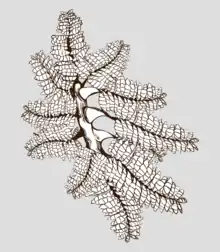| Hapsidophyllas Temporal range: Ediacaran | |
|---|---|
 | |
| Paleoart by Max Endieveri modeled after Bamforth & Narbonne | |
| Scientific classification | |
| Domain: | Eukaryota |
| Kingdom: | Animalia |
| Phylum: | †Petalonamae |
| Genus: | †Hapsidophyllas Bamforth and Narbonne, 2009 |
| Species: | †H. flexibilis |
| Binomial name | |
| †Hapsidophyllas flexibilis Bamforth and Narbonne, 2009 | |
Hapsidophyllas is a rare Ediacaran rangeomorph fossil found at Mistaken Point, Newfoundland, Canada. It was first identified by Emily Bamforth and Guy Narbonne in 2009. Its name comes from the Greek words for “a network of leaves.” Because its characteristic flexible leaflet structure is dissimilar to other known rangeomorphs, Bamforth and Narbonne describe it as a new rangeomorph form, called hapsidophyllid. The only other known hapsidophyllid is the Ediacaran frond Frondophyllas grandis, which shares the network-like configuration of leaflets seen in Hapsidophyllas. Currently, the Hapsidophyllas flexibilis holotype resides in its type locality in the Mistaken Point Ecological Reserve, and a cast of the specimen is on display at the Royal Ontario Museum in Toronto, Canada.[1][2]
The Hapsidophyllas flexibilis holotype is 110 mm long and 4 mm wide. It is composed of multibranched leaflets radiating from a single elongate basal rod. The leaflets gradually taper toward their distal ends and overlap one another. This leaf shape points towards a suspension feeding behavior.[1] The overlapping branches of Hapsidophyllas are architecturally similar to the renowned Ediacaran frond Charnia.[1] However, a significant difference between the two is that the primary branches of Charnia are connected to a central tube that is absent or internal, while hapsidophyllid leaflets are attached to a visible stalk.[3]
Sedimentary studies show that Mistaken Point organisms, including Hapsidophyllas, lived on the deep seafloor below the photic zone.[4] Because Mistaken Point organisms were preserved under deposit layers of volcanic ash, their proximity to the seafloor can be estimated based on the quality of their preservation. Due to its excellent preservation, it is estimated that the Hapsidophyllas flexibilis laid semi-prone to the seafloor in its life.[1]
References
- 1 2 3 4 Bamforth, Emily L.; Narbonne, Guy M. (2009). "New Ediacaran Rangeomorphs from Mistaken Point, Newfoundland, Canada". Journal of Paleontology. 83 (6): 897–913. doi:10.1666/09-047.1. ISSN 0022-3360. JSTOR 20627674. S2CID 86227242.
- ↑ Taylor, Rod S.; Matthews, Jack J.; Nicholls, Robert; Mcllroy, Duncan (2021). "A re-assessment of the taxonomy, palaeobiology and taphonomy of the rangeomorph organism Hapsidophyllas flexibilis from the Ediacaran of Newfoundland, Canada". Paläontologische Zeitschrift. 95 (2): 187–207. doi:10.1007/s12542-020-00537-4. S2CID 232377991.
- ↑ Brasier, Martin D.; Antcliffe, Jonathan B. (2009-03-01). "Evolutionary relationships within the Avalonian Ediacara biota: new insights from laser analysis". Journal of the Geological Society. 166 (2): 363–384. Bibcode:2009JGSoc.166..363B. doi:10.1144/0016-76492008-011. ISSN 0016-7649. S2CID 128827652.
- ↑ Narbonne, Guy M. (2005-05-31). "THE EDIACARA BIOTA: Neoproterozoic Origin of Animals and Their Ecosystems". Annual Review of Earth and Planetary Sciences. 33 (1): 421–442. Bibcode:2005AREPS..33..421N. doi:10.1146/annurev.earth.33.092203.122519. ISSN 0084-6597.